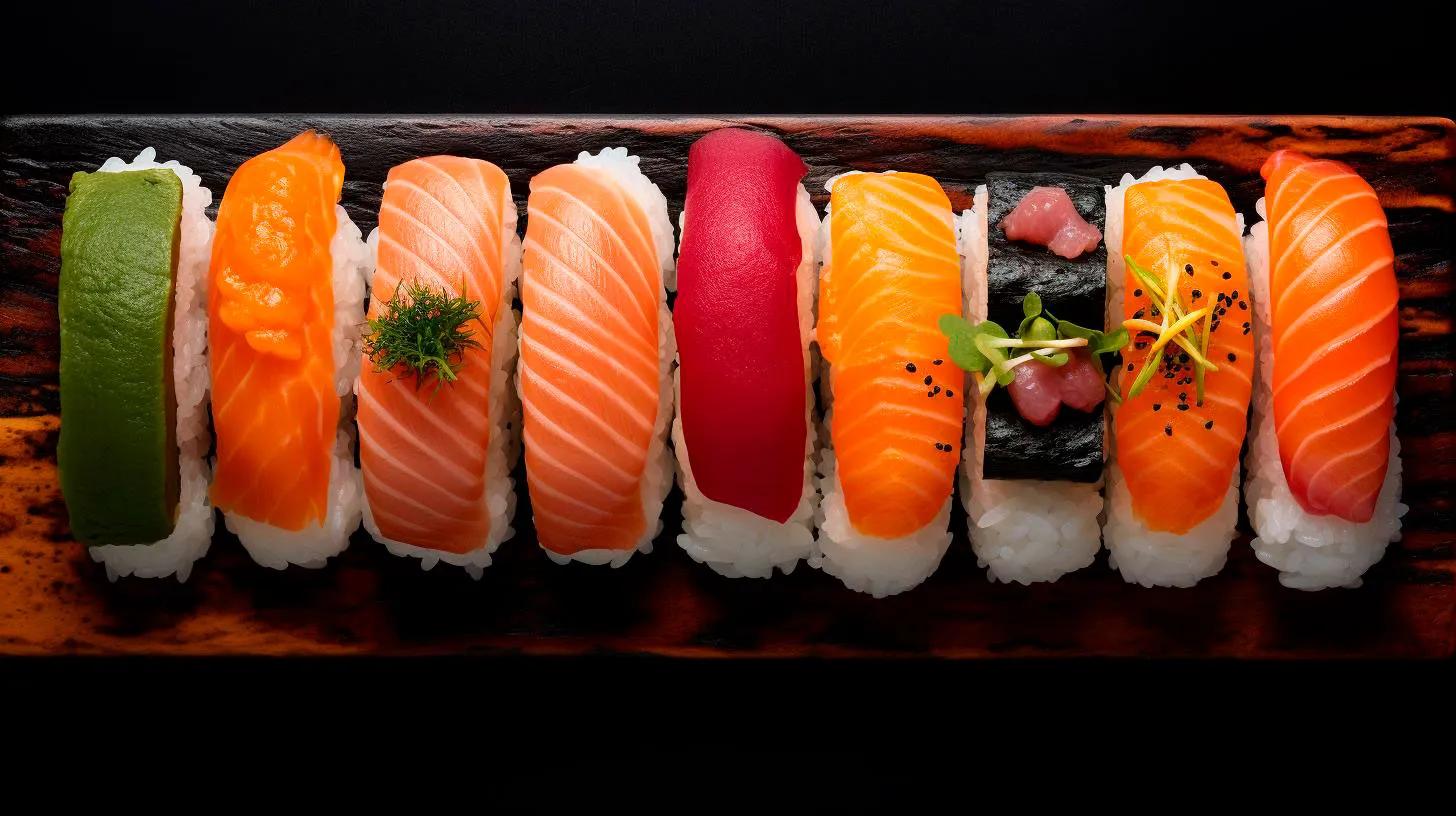Redefining Tradition: How American Sushi Innovations are Changing the Sushi Landscape
In this article, we delve into the exciting world of American sushi and explore how these unique variations are redefining tradition.
The Fusion of Cultures
American sushi, also known as “Western-style sushi,” has become a prominent part of the culinary scene, particularly in the United States. It reflects the blending of Japanese tradition with Western influences, resulting in a range of flavors and techniques that have captivated sushi lovers worldwide.
One of the key elements of American sushi is the creative usage of non-traditional ingredients, such as avocado, cream cheese, and various vegetables. These additions add a unique twist and expand the flavor profile, appealing to a broader audience. American sushi also embraces multiculturalism by incorporating elements from other cuisines, such as Mexican-inspired sushi rolls with spicy sauces and ingredients like jalapenos and cilantro.
Key Takeaway: American sushi combines traditional Japanese techniques with non-traditional ingredients and influences from other global cuisines, offering a diverse and exciting dining experience.
Rise of Sushi Burritos and Bowls
One of the most notable American sushi innovations is the introduction of sushi burritos and bowls. These larger-sized sushi creations are not only visually appealing but also convenient for those on the go. Sushi burritos, wrapped in seaweed and filled with a variety of ingredients, are a perfect fusion of sushi and Mexican flavors. They are often accompanied by unique dipping sauces, adding an extra layer of flavor.
Sushi bowls, also known as poké bowls, have gained immense popularity due to their customizable nature. These bowls typically include a base of rice or greens, topped with fresh seafood, vegetables, and delectable sauces. The versatility of sushi burritos and bowls allows for endless combinations, catering to individual preferences and dietary restrictions.
Key Takeaway: Sushi burritos and bowls offer a convenient and customizable way to enjoy sushi, providing a modern twist to the traditional sushi roll.
Sustainability and Seafood Alternatives
As the demand for sushi continues to grow, the issue of sustainability has gained prominence. American sushi chefs have been at the forefront of promoting sustainability by using alternative ingredients and sustainable sourcing practices. Sustainable seafood options, such as farm-raised or responsibly caught fish, have become more readily available.
In addition to sustainable seafood, American sushi has also embraced the use of alternative ingredients to cater to dietary preferences and restrictions. Vegetarian and vegan sushi rolls, utilizing ingredients like tofu, mushrooms, and avocado, have become increasingly popular. The utilization of plant-based alternatives allows a wider range of individuals to experience the flavors and textures of sushi.
Key Takeaway: American sushi promotes sustainability by incorporating alternative ingredients and supporting responsible sourcing practices, making sushi more accessible to a broader audience.
Technology’s Influence on Sushi Dining
Innovation in American sushi goes beyond culinary creations; technology has played a significant role in transforming the dining experience. Online ordering platforms and sushi delivery services have made it easier than ever to enjoy sushi from the comfort of one’s own home. Additionally, sushi restaurants have embraced interactive tabletop ordering systems, allowing patrons to customize their orders and explore new flavors.
The rise of social media has also influenced the presentation of sushi. Instagram-worthy sushi rolls, with vibrant and artistic plating, have become a trend, enticing diners with visual aesthetics. Sushi chefs are constantly experimenting with new techniques and presentations to captivate their customers’ attention both in person and on social media platforms.
Key Takeaway: Technology has revolutionized the way we order and experience sushi, offering convenience and enhancing the visual appeal of this beloved cuisine.
Conclusion
American sushi innovations have undeniably transformed the traditional sushi landscape. By embracing non-traditional ingredients, incorporating elements from different cultures, and prioritizing sustainability, American sushi offers a diverse range of flavors and options that appeal to a broader audience. The fusion of culinary traditions, coupled with technological advancements, has brought about an exciting evolution in the way we enjoy sushi. Whether you prefer traditional or American-style sushi, there is no denying the impact these innovations have had on the sushi dining experience.
The Sushi Evolution: From Ancient Japan to Modern International Cuisine
In this article, we will explore the history of sushi, its key components, and the remarkable impact it has on the culinary world today.
The Origins of Sushi
Sushi dates back to the 7th century in Japan when it was primarily consumed as a preservation method for fish. The ancient Japanese used fermented rice as a means to preserve the raw fish, resulting in a tangy and flavorful combination. This early form of sushi, known as narezushi, required the fish to be wrapped in salted and fermented rice for several months before being consumed.
Over time, sushi evolved into a delicacy favored by the upper class during the Edo period (1603-1868). During this time, a new sushi variation called haya-zushi emerged, where the fish was only marinated for a short period before serving. Vinegar was introduced to the rice during the fermentation process, enhancing the flavor and cutting down the fermentation time. This innovation led to the creation of a more palatable and visually appealing sushi dish.
The Introduction of Nori and Modern Sushi
In the 18th century, a significant development revolutionized the sushi landscape— the introduction of nori, the edible seaweed wrap. Prior to this innovation, sushi was served as bite-sized pieces without any wrapping. The addition of nori allowed for easier consumption and further expanded the possibilities for sushi makers.
It wasn’t until the 19th century that sushi truly started to resemble the modern dish we know today. Hanaya Yohei, a Tokyo-based chef, is credited with popularizing nigiri sushi—the hand-pressed sushi we commonly see today. Hanaya Yohei began serving bite-sized sushi topped with fresh fish, presenting a harmonious blend of flavors and textures.
The Sushi Revolution Goes Global
Sushi remained relatively confined to Japan until the mid-20th century when it began gaining popularity internationally. The introduction of refrigeration and improved transportation methods allowed for the export of fresh fish, making sushi accessible to people outside of Japan.
In the 1960s, Japanese immigrants started integrating sushi into their menus in the United States. As Asian cultures and cuisines gained recognition and appreciation, sushi began to capture the curiosity of food enthusiasts worldwide. Today, it has become a staple in many countries, with sushi bars and restaurants flourishing globally.
Key Components and Variations
1. Rice:
Rice is the foundation of sushi and plays a crucial role in its taste and texture. Short-grained, sticky rice is traditionally used for sushi preparation, as it allows for easy shaping and enhances the overall experience.
2. Fish and Seafood:
The selection of fish and seafood used in sushi varies depending on availability and cultural preferences. Common choices include tuna, salmon, shrimp, yellowtail, and eel. Sushi enthusiasts can also enjoy vegetarian options like cucumber, avocado, and tofu.
3. Nori:
Nori, the edible seaweed wrap, holds the sushi together and adds a subtle umami flavor. Its crisp texture provides a delightful contrast to the soft rice and fillings.
4. Wasabi and Soy Sauce:
Wasabi, a potent green paste made from Japanese horseradish, adds a spicy kick to sushi. Soy sauce, typically served alongside sushi, enhances the flavors and provides a savory touch.
The Advantages of Sushi
- Sushi is a versatile dish that accommodates various dietary preferences, including pescetarian and vegetarian options.
- Rich in omega-3 fatty acids and lean proteins, sushi can provide a healthy and balanced meal option.
- The presentation of sushi is visually appealing, making it an excellent choice for special occasions and fine dining experiences.
- Sushi’s bite-sized portions allow for easy sampling and sharing, creating a social and interactive dining experience.
- As an art form, sushi showcases the craftsmanship and skills of sushi chefs, emphasizing attention to detail and precision.
Key Takeaways
Sushi has transcended cultural boundaries and evolved into a universally beloved cuisine. Its journey from ancient preservation method to a globally recognized delicacy is a testament to its enduring appeal. Today, sushi continues to captivate diners with its exquisite flavors, elegant presentation, and adaptability. Whether you’re a sushi aficionado or a newcomer to this culinary delight, exploring the world of sushi opens up a world of gastronomic possibilities.
Sushi Fusion: Exploring the Delicious Blend of Japanese and American Culinary Traditions
The result is sushi fusion, a mouthwatering blend of East meets West that will leave your taste buds begging for more.
A Tantalizing Mix of Flavors
Sushi fusion takes the best of Japanese sushi and combines it with American flavors, resulting in a unique and delightful culinary experience. From classic sushi rolls with a twist to innovative creations that push the boundaries of traditional sushi, this fusion style offers an exciting array of flavors that cater to diverse palates.
Here are some popular sushi fusion dishes that showcase the tantalizing mix of Japanese and American flavors:
- Spicy Tuna Roll with Avocado: This fusion twist on the classic spicy tuna roll adds creamy avocado for a burst of freshness and an extra layer of texture.
- Philly Roll: Combining the flavors of a classic Philadelphia cream cheese bagel with sushi, this roll typically contains smoked salmon, cream cheese, and cucumber.
- Crunchy Tempura Roll: Tempura-battered vegetables or shrimp are added to sushi rolls, providing a delightful contrast of crispy texture against the softness of the rice and fish.
Aesthetics Meet Innovation
Sushi fusion not only tantalizes the taste buds but also captivates the eyes. The art of sushi presentation, known as “maki mono,” takes on new dimensions in this fusion style, combining traditional sushi-making techniques with innovative twists.
Key takeaways regarding the aesthetics and innovation of sushi fusion:
- Colorful Creations: Sushi fusion chefs bring vibrant colors to their creations by adding ingredients like colorful flying fish roe, vibrant edible flowers, and eye-catching sauces.
- Creative Shapes and Sizes: In sushi fusion, traditional cylindrical sushi rolls aren’t the only option. Chefs experiment with shapes like cones, squares, and even layers to create visually striking sushi pieces.
- Exciting Presentation Styles: Sushi fusion often incorporates unique presentation techniques, such as arranging sushi on a bed of crushed ice or using unconventional serving vessels.
The Rise of Sushi Fusion
Sushi fusion has gained immense popularity, not just among food enthusiasts but also among some of the world’s most renowned chefs. Here are some interesting statistics related to the rise of sushi fusion:
- According to a survey conducted by Statista: The global sushi market was valued at $16.1 billion in 2020 and is projected to reach $24.6 billion by 2027, with sushi fusion contributing to this growth.
- 50% of sushi bars in the United States: Incorporate fusion-inspired sushi rolls onto their menus, catering to the evolving tastes and preferences of customers looking for innovative dining experiences.
- Top food influencers: Showcasing sushi fusion creations on social media platforms have seen a significant increase in engagement and following, highlighting the growing interest in this culinary trend.
The Best of Both Worlds
Sushi fusion is more than just a culinary trend; it’s a celebration of the best that Japanese and American cuisines have to offer. By blending the delicate flavors and techniques of Japanese sushi with the bold and diverse ingredients of American cuisine, sushi fusion offers a truly unique dining experience.
Key takeaways regarding the benefits and key features of sushi fusion:
- Expanding Palates: Sushi fusion introduces new flavor combinations, allowing diners to experience a wide range of tastes in one bite.
- Diverse Options: It caters to different dietary preferences and restrictions, offering vegetarian, gluten-free, and even vegan options that maintain the essence of sushi fusion.
- Unforgettable Experience: With its innovative flavors, stunning presentation, and unique blend of traditions, sushi fusion is not just a meal but an unforgettable culinary adventure.
In conclusion, sushi fusion breathes new life into the world of sushi, drawing inspiration from the best of Japanese and American culinary traditions. With its tantalizing mix of flavors, innovative presentations, and a rising popularity, sushi fusion offers a vibrant and exciting dining experience that is here to stay.
Japanese Sushi vs American Sushi: Contrasting Techniques and Flavor Profiles
In this article, we will explore the differences between Japanese and American sushi, including their contrasting preparation methods, ingredients, and overall taste.
Techniques and Preparation
Japanese sushi is deeply rooted in centuries-old traditions and requires exceptional skills to master. Key techniques used in Japan include:
- Shari: The art of perfectly seasoned sushi rice, where the balance of vinegar, salt, and sugar is crucial.
- Nigiri: Hand-pressed sushi typically consisting of a small mound of rice topped with fresh seafood or other ingredients.
- Maki: Sushi rolls made by wrapping ingredients in nori seaweed and tightly rolling them together using a bamboo mat.
- Sashimi: Fresh, raw slices of fish or other seafood, served without rice.
American sushi, on the other hand, has adapted these techniques to create a unique fusion of flavors. Common techniques found in American sushi include:
- California Roll: Invented in Los Angeles, this sushi roll introduced avocado and crab meat, making it more approachable to those new to sushi.
- Spicy Tuna Roll: A popular roll made with raw tuna mixed with mayonnaise and spices, offering a spicy kick.
- Tempura: The technique of deep-frying ingredients before rolling them into sushi, adding a crunchy texture.
Flavor Profiles
Japanese sushi focuses on the natural flavor of the ingredients, aiming to achieve a delicate balance between the rice, fish, and other components. The subtle taste of Japanese sushi is often enhanced by light soy sauce, wasabi, and pickled ginger. Key flavor elements of Japanese sushi include:
- Freshness: Japanese sushi emphasizes the use of the freshest ingredients, with an emphasis on seasonal seafood.
- Umami: The fifth taste sensation, umami, is showcased through the rich flavors of the fish and ingredients used.
- Simplicity: Japanese sushi celebrates simplicity, allowing the natural flavors to shine through without overpowering sauces or seasonings.
American sushi, in contrast, embraces a more adventurous and diverse flavor profile that caters to a broader range of tastes. American sushi may incorporate unconventional ingredients like cream cheese, avocado, and spicy sauces to create unique and bold flavor combinations. Key flavor elements of American sushi include:
- Customization: Americans appreciate the ability to create their own rolls and experiment with a wide range of ingredients and sauces.
- Dynamism: American sushi often showcases vibrant flavors and varied textures, appealing to those seeking a more dynamic dining experience.
- Fusion: Inspired by the melting pot of cultures in the United States, American sushi melds different culinary traditions to create innovative and exciting combinations.
Key Takeaways
When contrasting Japanese and American sushi, it is important to consider the techniques, ingredients, and flavors that define each style. Here are some key takeaways:
- Japanese sushi relies on centuries-old techniques and a focus on simplicity, highlighting the natural flavors of fresh ingredients.
- American sushi offers a more diverse and adventurous approach, incorporating unconventional ingredients and catering to individual customization.
- While Japanese sushi emphasizes delicate flavors and umami, American sushi celebrates bold and dynamic taste profiles.
- Both styles of sushi offer unique culinary experiences, catering to different preferences and allowing for a myriad of creative possibilities.
Ultimately, whether you prefer the traditional elegance of Japanese sushi or the bold, fusion-inspired tastes of American sushi, both styles offer a delightful journey into the world of sushi, showcasing the artistry and creativity of talented sushi chefs around the globe.


